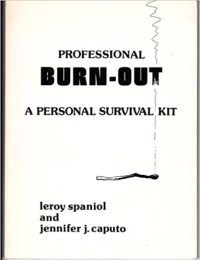I was giddy. It was a book published in 1977. Professional Burn-Out wasn’t that big, but it was a book that predated Freudenberger’s Burn-Out book, which was published in 1980. It still cited his journal articles on the topic – but very few people would even know about this book. I have to credit The Burnout Challenge for directing me to it. In the irony of ironies, it further discredits the premises in The Burnout Challenge.
Outline
Rarely do I share outlines more or less directly from a book – but here, the outline shines light on the idea of burnout and its factors. It starts with looking at personal and professional factors for burnout:
- Personal Sources of Burnout
- Not Setting Limits (see Boundaries)
- Not Paying Attention to Our Own Needs and Limits
- Not Communicating Our Feelings
- Isolating Ourselves Physically and Psychologically (see Loneliness and Acedia & Me)
- Political Nature of Work
- Powerlessness (see The Hope Circuit)
- Ignoring Positive Attention from Others
- Lack of Professional Identity
- Becoming Overinvolved
- Professional Survival Skills
- Inability to Live with “Gray Areas” of Life
- Organizational Sources of Burnout
- Not Including Staff in Policy Making Procedures (see Reinventing Organizations)
- Lack of Structure that Allows People to Share Strong Positive and Negative Feelings (see The Fearless Organization)
- Lack of Positive Feedback
- Lack of Ability to Personalize Workspace
- Not Sharing Wants and Needs and Not Encouraging Others to Do the Same (see Radical Candor)
- Lack of Adequate Supervision
- Dead-End Jobs
- Lack of Skill-based Training
- Few External Rewards
- Limited Vacation Time
- High Client/Staff Ratio
What’s key here is that many of these same concepts have shown up in other work since publication – and many of these are directly addressed by our bathtub model as explained in Extinguish Burnout.

Three Degrees
Professional Burn-Out proposes that there are three levels of burnout:
- First: Signs and symptoms are experienced mildly and occasionally.
- Second: Signs and symptoms are more persistent and difficult to move out of.
- Third: Signs and symptoms are continuous. Psychological problems begin to accompany the signs of burnout.
Signs and Symptoms
The list of signs and symptoms at a personal level include:
- Fatigue – This label to what is commonly called exhaustion today.
- Worry – This also includes an inability to separate work from the rest of our lives.
- Inability to make decisions – This is commonly seen when someone is overwhelmed. (See The Organized Mind.)
- Guilt – Here, there’s a sense that the work that is being done isn’t of high enough quality. Today, this is often called inefficacy. We’re guilty, because we don’t feel effective enough. (See I Thought It was Just Me (But It Isn’t) for more on guilt.)
- Physical symptoms – Often, our minds impact our bodies. We continue to find that our physical symptoms are driven by our minds. (See Why Zebras Don’t Get Ulcers for more.)
- Alienation – We see that we’re disconnecting from friends. This leads to feelings of Loneliness.
- Criticism/Griping – Today, we generally call this cynicism. Cynicism is the result of our feelings of inefficacy. (If you want more about an appropriate level of happiness, see Bright-Sided.)
- Anger/Resentment – Also known as being “snappy”. (See A Force for Good for more about how to work on anger.)
- Accident proneness – Another sign of cognitive exhaustion associated with high levels of stress, people may start bumping into walls. (See The Rise of Superman about chemical exhaustion in the brain.)
At an organizational level, we’ve seen an increased awareness of the problems of engagement, which closely track what we see at an individual level as burnout. Gallup has routinely demonstrated that about one-third of people are engaged, one-third are neutral, and one-third are actively disengaged. The reported symptoms are:
- Increased absenteeism
- Low level enthusiasm
- Quality of service declines
- Lack of focus
- High level of complaints
- Lack of communication
- Lack of acknowledgement of “strokes”
- Lack of openness to new ideas
Strategies for Dealing with Burnout
The book continues with a list of strategies for dealing with burnout, both personally and organizationally.
The personal strategies are:
- Awareness
- Contact
- Peer professional
- Work under good supervision
- Personal skill building
- Carving out professional time
- Help without rescuing
- Personal work contract
- Dealing with one’s own unfinished business
- Work with someone you like
- Learning to relax without having to work hard at it
- Regular exercise
- Nutrition
- Learning and using assertive skills
- Making a want list
- Be creative with anger
- Take time and space for yourself
Organizational strategies are:
- Encourage staff to express feelings
- Support/Encourage and reward risk taking
- Provide ongoing supervision
- Encourage sharing of needs and wants
- Invite staff to participate in policy and decision making
- Train staff in burnout
- Train supervisory staff in burnout
These approaches are not fundamentally different today than back then – even if few people are able to do all of them. Perhaps that’s why Professional Burn-Out remains a problem today.


No comment yet, add your voice below!